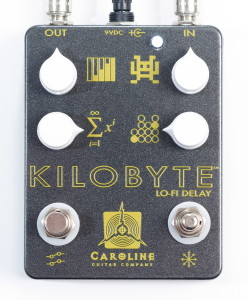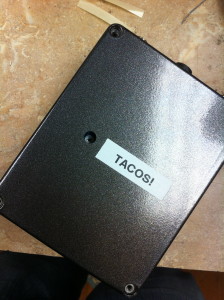 Is the Kilobyte an analog delay pedal?
Is the Kilobyte an analog delay pedal?
No. An actual analog delay pedal means that it is using a BBD (bucket brigade) analog chip for creating the repeats. Our Kilobyte™ is what we call a lo-fi delay, using an analog dry path, and a low fidelity, bandwidth reduced PT2399 digital delay chip for creating the repeats. The paths are kept separate until they are merged in a summing amplifier, with the delay level control setting the overall volume of the repeated signal in the mix.
We feel that the circuit we designed around this digital chip, with our preamp and filtering, is incredibly warm and rich sounding, and we’ve had many people swear upon trying it out that Kilobyte must be an analog delay pedal.
Why do some Kilobytes I’ve seen have five knobs, while most others have four?
We included the fifth control knob for controlling the “Tacos” as a thank-you to our Kickstarter project backers for paying a premium price for this pedal when all we had was a prototype and a promise. All of the sonic features in the Kickstarter versions are available in the pedal from our retailers. The fifth knob is an internal trimpot on this version, so that modulation is still available. Should you wish to have it on an external 5th knob like the Kickstarter version, we can modify your pedal for you for $30 + shipping.
 The other option, which we recommend, is simply removing the back plate and then drilling a small 1/4″ hole, centered 1″ from the left side and 2-3/8″ from the bottom. This will allow you to adjust the “modulation” degree with a small Phillips head screwdriver. If you’re feeling playful, we even recommend you label yours like we did to this pedal.
The other option, which we recommend, is simply removing the back plate and then drilling a small 1/4″ hole, centered 1″ from the left side and 2-3/8″ from the bottom. This will allow you to adjust the “modulation” degree with a small Phillips head screwdriver. If you’re feeling playful, we even recommend you label yours like we did to this pedal.
What exactly does the “Tacos” control on the inside do?
The Tacos control allows you to gently tweak the subtle amount of pitch shifting and detuning in the repeats. It can help make things get really dreamy. Just gently insert a Phillips head screwdriver into the trimpot and tune it to taste.
Why did you call it “Tacos”?
This was a bonus, unplanned feature. We were doing so well at our Kickstarter that we decided to create this as an add-on with our friend Jack DeVille from Mr. Black Pedals, whom we contracted for our PCB layout. (Ever see a sports team beat another so badly that they give the fans free tacos, like this? That’s how triumphant we were feeling – thanks again to our supporters!)
Do you have a manual available online?
Yes we do – you may view or download it here.
Some Kilobytes are black, others light blue, and some are grey. What’s the difference?
There are no sonic differences. The black and gold sparkle finish was for our Kickstarter supporters and other advance customers who paid a premium to have this pedal before general release. The lighter Mercedes blue with white graphics was a limited run of pedals for retailers. Our standard color is Kingsport Grey. It’s a cool, gun-metal color that looks really terrific in person.
Ah man! I want one of the limited edition color!
Take heart – they are out there, good hunting. That being said, to be perfectly candid, when we’re talking about small-batch, handmade boutique effect companies like ours, every pedal made is a limited edition!
Any chance of custom or artist painted limited runs (like Cannonballs) of Kilobyte becoming available in the future?
Most definitely.
What is the maximum delay time in milliseconds?
We don’t specify an exact maximum because there are some variables and tolerances within the parts involved. The variables are tolerances in the delay chip, and as much as 20% variation in the potentiometer/control knob that sets the delay time. That’s why we confidently promise over 500 milliseconds. Units that we clocked here in Columbia ranged from 524 on the low side to the low 600s, but we’ve heard of some people getting as much as 815 (whoa) milliseconds from their Kilobyte.
Why does this pedal get much more noisy past 12:00 on the binary clock?
The PT2399 is really designed for up to 300ms of delay time. After that point, you can see the THD (distortion) start to spike upwards. We felt that this texture can still be kind of cool on long delay times – it’s a bit of white noise, speaker rub, snare rattle, phonograph scratch, you can call it what you will. But mixed with the analog overdrive preamp, it can make for some very cool textures. Again, like with the Wave Cannon, we’re not here to ‘nanny-state’ or shoehorn you only into sounds that are considered pleasant or “acceptable”. You can dial up as much of that dirty delay as you wish.
Why isn’t this pedal tap-tempo?
Because the chip is this noisy at higher delay times, and even kind of gritty on lower ones, we felt this design isn’t very well suited towards that kind of lock step, perfectly lined up dominoes delay. Instead we went for more of a smeared, degraded sound, and focused on other cool, ambient sounding features.
So what does the momentary switch do then if it isn’t tap tempo?
The Havoc™ option on this pedal is a high-pass filtered (reduced bass) runaway oscillation. Hold it down to override the feedback/summation control for infinite, escalating repeats. Release it to return to your existing settings.
That Havoc control can get kind of loud. In fact, this whole pedal seems like it can get pretty loud.
Yes it can. We wanted unity volume between the repeats and the original signal by setting the Level at 12:00 and the Attack/preamp all the way down. Any extra “Attack” boosts and drives the repeats, so to compensate, you can turn the level control down.
Does the analog overdrive/preamp affect the dry signal?
No. Your dry instrument signal hits a high-impedance unity gain buffer/splitter and is sent to the summing amplifier. The other half of the split is sent to the preamp and then to the delay chip.
Is this pedal true bypass?
Yes. All of our pedals are true-bypass with a high quality, rugged 3PDT mechanical switch.
Does this require some kind of funky power supply or adapter cable?
Nope. It runs on all the industry standard 9VDC power supplies, like the Boss PSA-120, One Spot, Powerall, Pedal Power Plus, or equivalents.
Can Ellie Goulding really sing, or does she just make weird noises through an auto-tuner?
We think she can sing quite well, we’ve heard from very trusted sources who have heard her in person. This video is also pretty compelling evidence.
Who can I contact if this didn’t answer my questions?
Drop us a line here.
